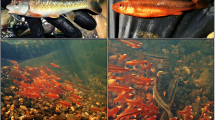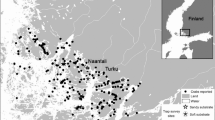Abstract
Fishes of the genus Rhinogobius (Gobiidae) display paternal care of their nests, constructed beneath stones. Rhinogobius flumineus often coexist with larger Rhinogobius congeners (hence, stronger competitors for the nest site). To understand how R. flumineus reproduce successfully with the presence of a potential nest site competitor, nest-use characteristics of R. flumineus and Rhinogobius nagoyae were investigated in two rivers in southern central Honshu, Japan: one site with both species in sympatry and the other site with R. flumineus in allopatry. Analyses of nest stone, egg clutch, and male body sizes demonstrated that reproductive success, namely the number of eggs deposited, increased with male body size in both species and was positively correlated with nest stone size only in R. nagoyae. The pattern that R. flumineus males are less insistent on using large stones for nesting may partly explain the coexistence mechanism of the two species.

Similar content being viewed by others
References
Breitburg DL (1987) Interspecific competition and the abundance of nest sites: factors affecting sexual selection. Ecology 68:1844–1855
Ito S, Yanagisawa Y (2003) Mate choice and mating pattern in a stream goby of the genus Rhinogobius. Environ Biol Fishes 66:67–73
Kani T (1944) Ecology of torrent-inhabiting insects. In: Furukawa H (ed) Insects 1. Kenkyu-shya, Tokyo, pp 171–317 (in Japanese)
Kawanabe H, Mizuno N (1989) Freshwater fishes of Japan. Yama-kei, Tokyo (in Japanese)
Leino JR, Mensinger AF (2017) Interspecific competition between the round goby, Neogobius melanostomus, and the logperch, Percina caprodes, in the Duluth-Superior Harbour. Ecol Freshw Fish 26:34–41
Lindström K (1988) Male-male competition for nest sites in the sand goby, Pomatoschistus minutus. Oikos 53:67–73
Lugli M, Bobbio L, Torricelli P, Gandolfi G (1992) Breeding ecology and male spawning success in two hill-stream populations of the freshwater goby, Padogobius martensi. Environ Biol Fishes 35:37–48
Matsumoto T, Nagoshi M (1996) Egg mass of nesting site of the freshwater goby Rhinogobius flumineus and environmental condition. Biol Inl Wat 11:30–35 (in Japanese)
Mizuno N (1960) Study on a freshwater goby, Rhinogobius similis Gill, with a proposition on the relationships between land-locking and speciation of some freshwater gobies in Japan. Mem Coll Sci, Univ Kyoto, Ser B 27:97–115
Mizuno N, Uehara S, Maki M (1979) Study on a freshwater fish, Rhinogobius brunneus (Gobiidae) IV. Habitat segregation among sympatric populations of 4 color types. Japan J Ecol 29:137–147 (in Japanese with English synopsis)
Mizuoka S (1962) Studies on fluvial variations in the gobioid fishes, “Yoshinobori” I. Two types in the Ota River. Bull Fac Edu Hiroshima Univ, Part 2 10:71–95
Nakabo T (2018) The natural history of the fishes of Japan. Syougakukan, Tokyo (in Japanese)
Oto Y, Masuda R (2019) Size-dependent habitat use in the stream goby Rhinogobius flumineus is affected by a larger sympatric congener. Ichthyol Res 66:393–399
Takahashi D, Kohoda M, Yanagisawa Y (2001) Male-male competition for large nests as a determinant of male mating success in a Japanese stream goby. Ichthyol Res 48:91–95
Tamada K (1986) Size variation of a freshwater goby, Rhinogobius brunneus, cross-band type, along the river length in terms of age and growth. The Nanki Seibutu 28:22–34 (in Japanese)
Tamada K (2001) Clutch and egg size in the three species of Rhinogobius complex dwelling in a single stream. Jpn J Ichthyol 48:49–52 (in Japanese with English abstract)
Tamada K (2011) River bed features affect the riverine distribution of two amphidromous Rhinogobius species. Ecol Freshw Fish 20:23–32
Tamada K, Iwata K (2005) Intra-specific variations of egg size, clutch size and larval survival related to maternal size in amphidromous goby. Environ Biol Fishes 73:379–389
Tamada K, Yamamoto J (1987) Distribution of four types of Rhinogobius brunneus and Rhinogobius flumineus in the southern part of Kii Peninsula. The Nanki Seibutu 29:15–20 (in Japanese)
Tamada K, Yamamoto J (1988) Distribution of four types of Rhinogobius brunneus and Rhinogobius flumineus in the southern part of Kii Peninsula - II. The Nanki Seibutu 30:109–114 (in Japanese)
Tamada K (2008a) Variation in male mating success in the paternal nest brooder, Rhinogobius goby, along a river course. Ecol Res 23:91–97
Tamada K (2008b) Estimate of mating pattern of a paternal nest brooder goby of Rhinogobius, using egg density in the nest. Ichthyol Res 55:191–197
Taru M, Kanda T, Sunobe T (2005) Competition for spawning sites between two gobiid fishes, Bathygobius fuscus and Eviota abax, derived by alteration of mating tactics of the former. Ichthyol Res 52:198–201
Uehara S (1996) Distributions of six species of Rhinogobius on the coastal area of Ise Bay, Japan. Jpn J Ichthyol 43:89–99 (in Japanese with English abstract)
Acknowledgments
This study was partially supported by a grant in aid for science research (No. 22924004) from the Ministry of Education, Culture, Sports, Science and Technology of Japan. I thank the anonymous reviewers and the section editor for helpful comments that improved the manuscript.
Author information
Authors and Affiliations
Corresponding author
Ethics declarations
Conflict of interest
The author has no conflict of interest to declare.
Ethics approval
All fish were handled according to the Japanese Ministry of Education, Culture, Sports, Science and Technology.
Additional information
Publisher's Note
Springer Nature remains neutral with regard to jurisdictional claims in published maps and institutional affiliations.
About this article
Cite this article
Tamada, K. Nest-use pattern of fluvial goby (Rhinogobius flumineus) in relation to the presence or absence of amphidromous congener: a case study of two rivers in southern central Honshu, Japan. Ichthyol Res (2024). https://doi.org/10.1007/s10228-024-00964-2
Received:
Revised:
Accepted:
Published:
DOI: https://doi.org/10.1007/s10228-024-00964-2




